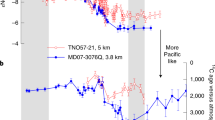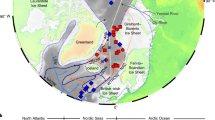Abstract
The conversion of surface water to deep water in the North Atlantic results in the release of heat from the ocean to the atmosphere, which may have amplified millennial-scale climate variability during glacial times1 and could even have contributed to the past 11,700 years of relatively mild climate (known as the Holocene epoch)2,3,4. Here we investigate changes in the carbon-isotope composition of benthic foraminifera throughout the Holocene and find that deep-water production varied on a centennial–millennial timescale. These variations may be linked to surface and atmospheric events that hint at a contribution to climate change over this period.
Similar content being viewed by others
Main
We used an established deepwater proxy parameter — the carbon-isotope composition (δ13C) of the epifaunal benthic foraminifera Cibicidoides wuellerstorfi5,6 — to evaluate Holocene deepwater variability. Variations in the δ13C of the total amount of CO2 in bottom waters, which is accurately recorded by C. wuellerstorfi, can be used to monitor variations in the contribution of high-δ13C North Atlantic Deep Water (NADW) relative to low-δ13C Southern Ocean Water (SOW) to a site. We worked on sediment from Ocean Drilling Project site 980 (55° N, 15° W; depth, 2,179 m), on the Feni Drift in the subpolar northeastern Atlantic.
Holocene δ13C values (Fig. 1, and see supplementary information) show marked millennial oscillations around the modern value of about 1‰ (ref. 7). Values range from a high of 1.3‰ to values lower than 0.6‰, indicating times of enhanced and reduced NADW contribution, respectively. The largest reductions in the relative NADW contribution occurred around 9,300 years ago (9.3 kyr), and 8.0, 5.0 and 2.8 kyr ago. Smaller events occurred more frequently.
Triangles, dated levels in sediment cores; arrow marks the onset and intensificatoin of the 5-kyr event. Accelerator mass-spectrometer radiocarbon dates converted to calendar age13 from site 980 provided the chronology for the Holocene (see supplementary information). Accumulation rates average about 25 cm kyr−1 in the Holocene, roughly double that in nearby core V29-191. The average interval between samples is about 100 yr from 9.7 to 1.2 kyr. Shading shows low-δ13C events (see text) and possible correlative events in the other records; a more tenuous correlation is denoted by the question mark. Rectangles, extreme winter-like conditions deduced from statistical analysis of the full set of palaeochemical indicators from GISP2 (ref. 8).
The most pronounced feature of the Holocene is a trend of decreasing relative NADW contribution that began at about 6.5 kyr and culminated with a minimum at around 5 kyr. Statistical analysis of the full set of chemical records from the Greenland Ice Sheet Project 2 (GISP2) ice core indicates that meteorological conditions from 6.1 to 5.0 kyr were especially winter-like (characterized by an expanded polar vortex) at high latitudes; this is consistent with high values of sea-salt sodium (Fig. 1) during this millennial-scale event8.
A high relative abundance of haematite-stained grains in a nearby core indicates a large proportion of cold, fresh, ice-bearing surface water from north of Iceland2. All three records indicate that the 5-kyr event was the most severe climate event of our Holocene study interval. Apparently contemporary variations in benthic δ13C and sea-salt sodium levels indicate that linked, century-scale variability may have occurred during this event.
The GISP2 palaeochemical records indicate enhanced winter-like conditions from 2.4 to 3.1 kyr, and from 8.8 to 7.8 kyr, although to a lesser extent than in the 5-kyr event8. The more recent of these cold intervals corresponds precisely to the reduced NADW contribution at around 2.8 kyr. The 8-kyr δ13C minimum occurs late in the 8.8–7.8-kyr cold interval, but corresponds to a brief maximum in sea-salt sodium. The age of the 9.3-kyr event is poorly constrained, but it may correspond to one of several younger or older maxima in sea-salt sodium flux. Three of the four low-δ13C events correspond to maxima in the percentage of haematite-stained grains (increased incursion of rock-bearing ice from north of Iceland), suggesting a possible surface–deepwater linkage.
Prior geochemical evidence for deepwater reduction in the Holocene was limited to events outside our study interval. Low δ13C values during the Little Ice Age4, the most recent of the Holocene millennial cold events8, and during an early Holocene event at ∼10.3 kyr (ref. 9) hint at a linkage between millennial climate and deep water. Downcore variations in sedimentological indices also indicate this possibility10,11.
The new North Atlantic benthic δ13C record unambiguously demonstrates that NADW varied on centennial–millennial time scales during the Holocene. The most significant Holocene event of reduced NADW contribution, which occurred at 5 kyr, was correlated to winter-like atmospheric conditions at high northern latitudes8, and to incursion of sea ice from north of Iceland2. Similarly, a more recent cold event (at 3.1–2.4 kyr) was associated with a reduced NADW contribution.
Evidence for a climate–deepwater linkage during the earlier events is weaker, and may indicate an increasing sensitivity of deepwater to surface forcing from the Early to the Late Holocene. Further well-dated deepwater proxy records are needed to test this possibility.
Our study raises other important issues that can be addressed through data collection and modelling. The amplitude of the largest Holocene δ13C fluctuation near 5 kyr, for example, is similar to those of δ13C oscillations during earlier glacial and deglacial events12. This suggests that significant variations in the relative NADW contribution can occur in the absence of forcing by large ice sheets, and that NADW may be more sensitive to surface forcing than was previously imagined.
References
Broecker, W. S., Bond, G. & Klas, M. Paleoceanography 5, 469–477 (1990).
Bond, G. C. et al. Science 294, 2130–2136 (2001).
Alley, R. B. et al. Geology 25, 483–486 (1997).
Keigwin, L. D. & Boyle, E. A. Proc. Natl Acad. Sci. USA 97, 1343–1346 (2000).
Curry, W. B., Duplessy, J. C., Labeyrie, L. D. & Shackleton, N. J. Paleoceanography 3, 317–341 (1988).
Duplessy, J. C. et al. Paleoceanography 3, 343–360 (1988).
Kroopnick, P. M. Deep-Sea Res. 32, 57–84 (1985).
O'Brien, S. R. et al. Science 270, 1962–1964 (1995).
Bond, G. C. et al. Science 278, 1257–1266 (1997).
Bianchi, G. G. & McCave, I. N. Nature 397, 515–517 (1999).
Chapman, M. R. & Shackleton, N. J. Holocene 10, 287–291 (2000).
McManus, J. F., Oppo, D. W. & Cullen, J. L. Science 283, 971–975 (1999).
Stuiver, M. & Braziunas, T. F. Radiocarbon 35, 137–189 (1993).
Author information
Authors and Affiliations
Corresponding author
Ethics declarations
Competing interests
The authors declare no competing financial interests.
Supplementary information
Rights and permissions
About this article
Cite this article
Oppo, D., McManus, J. & Cullen, J. Deepwater variability in the Holocene epoch. Nature 422, 277 (2003). https://doi.org/10.1038/422277b
Issue Date:
DOI: https://doi.org/10.1038/422277b
This article is cited by
-
Evolution characteristics of the Atlantic Meridional Overturning Circulation and its thermodynamic and dynamic effects on surface air temperature in the Northern Hemisphere
Science China Earth Sciences (2023)
-
Internal multi-centennial variability of the Atlantic Meridional Overturning Circulation simulated by EC-Earth3
Climate Dynamics (2023)
-
Holocene vegetation and hydrology variations and their associations with climate changes: a multi-proxy analysis of a sediment core from an alpine basin in the middle Tianshan Mountains
Climate Dynamics (2021)
-
Variability of the grain-sized fractions during the last three millennia within the sedimentary fillings of the saline system of Mhabeul: the Holocene cyclostratigraphy
Arabian Journal of Geosciences (2019)
-
The 5.5 cal ka BP climate event, population growth, circumscription and the emergence of the earliest complex societies in China
Science China Earth Sciences (2018)
Comments
By submitting a comment you agree to abide by our Terms and Community Guidelines. If you find something abusive or that does not comply with our terms or guidelines please flag it as inappropriate.




